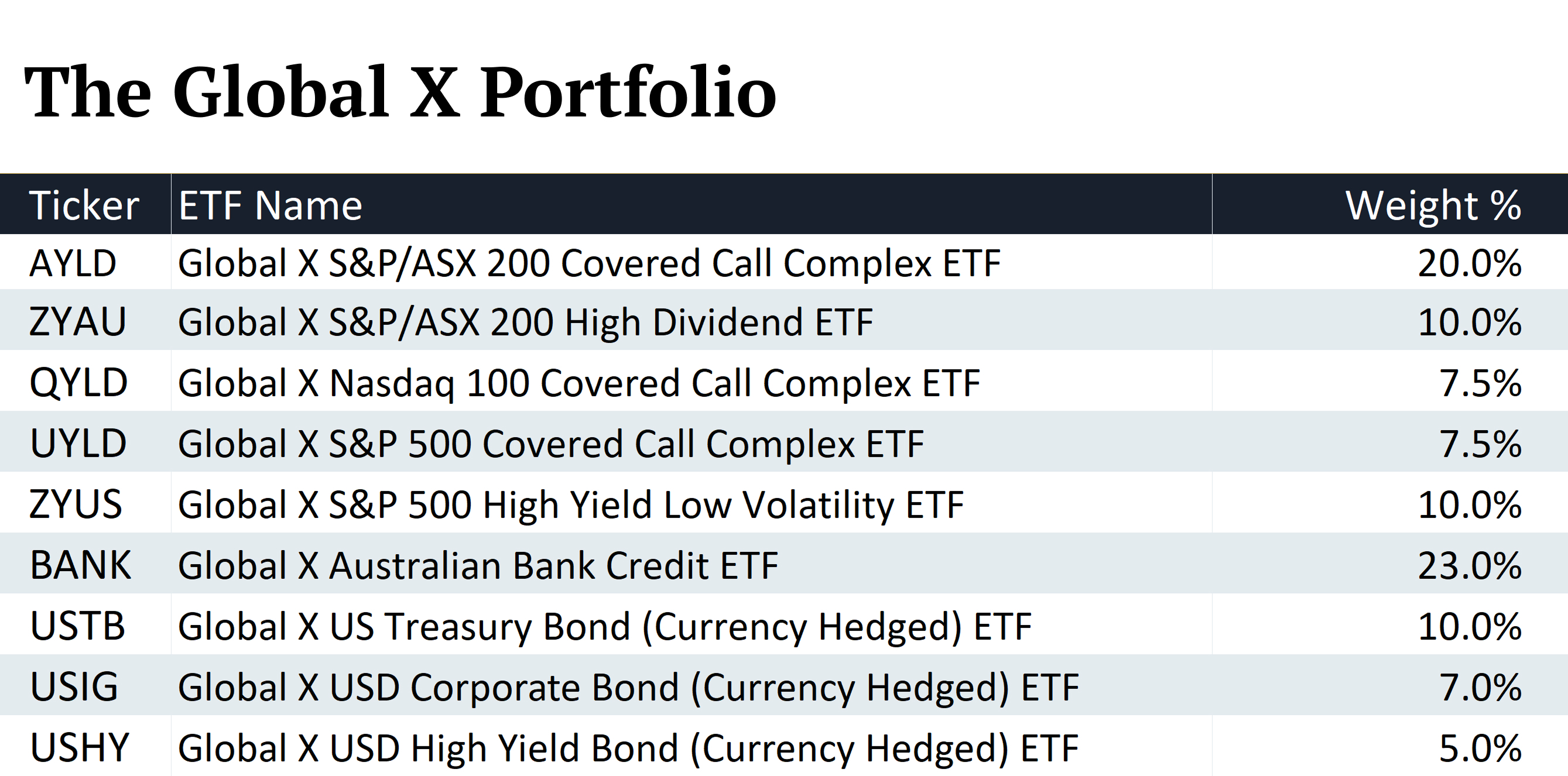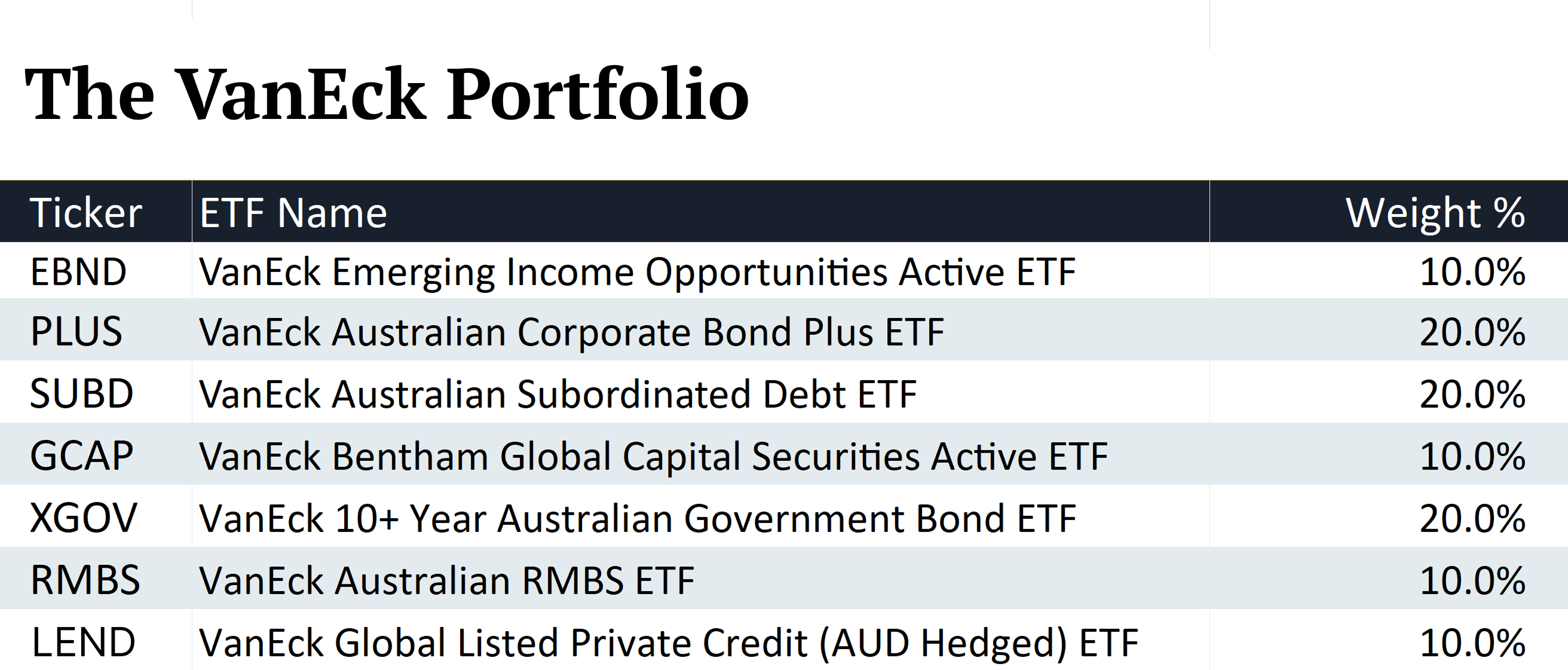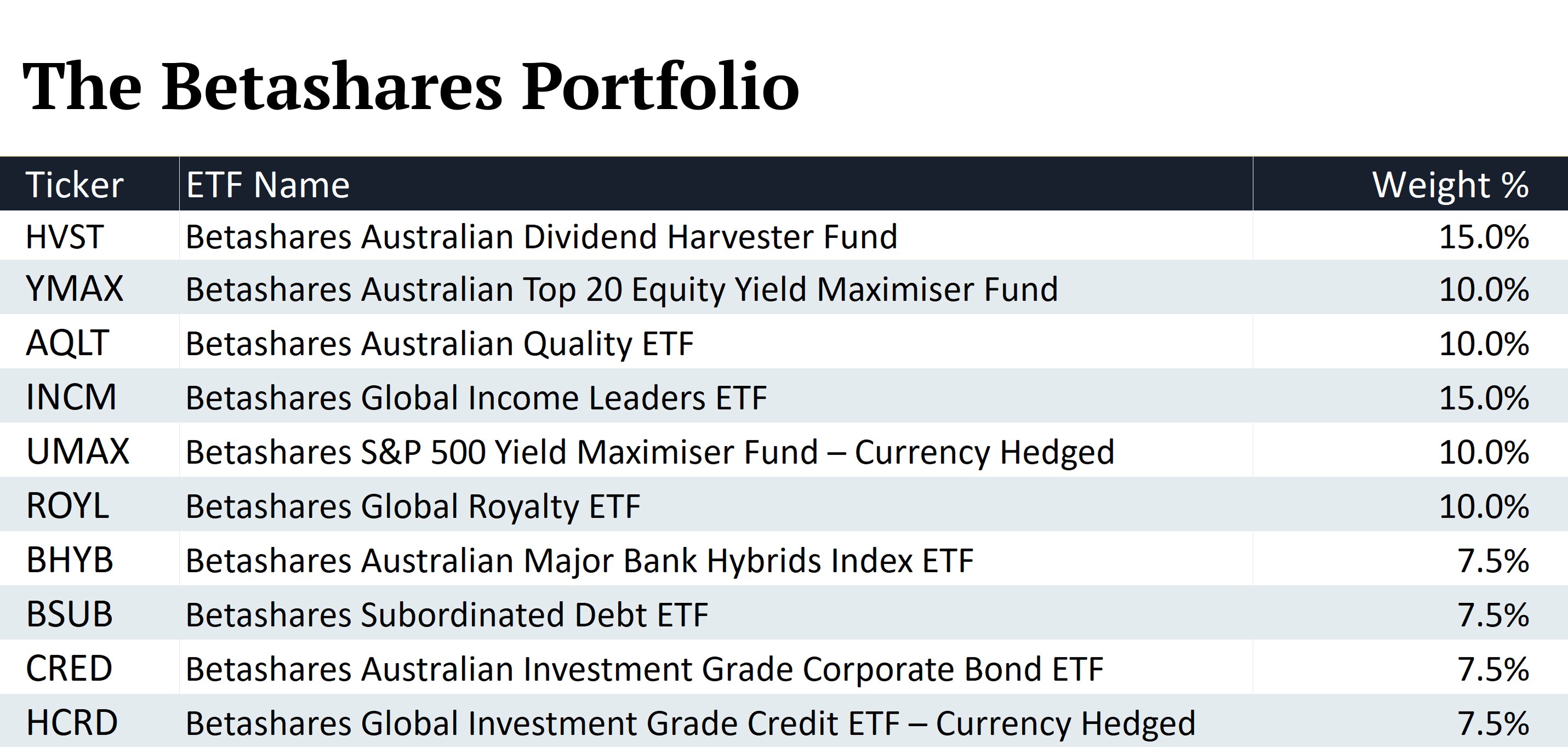3 high-yield ETF portfolios yielding 5.5-7%: Built by the fundies themselves
The old income playbook is falling apart.
Savings accounts and term deposits now average under 3%, according to the RBA, as banks brace for rate cuts. CBA yields just 2.65%, and with a P/E of 30, it’s looking more like a growth stock than an income staple. Other bank yields are sliding too, thanks to rising share prices.
The ASX 200 yields 3.5%, Aussie bonds 3.9%. Solid, but not exciting, especially after inflation. Even bank hybrids, long relied on for high income with lower volatility, are on their way out by 2032.
So we threw down a challenge to the ETF issuers by asking:
How do you build high and sustainable yield without too much risk?
Given they build the tools, we asked them to use those tools and construct full ETF income portfolios for today’s market. Here’s what they delivered:
- Global X: ~7% yield from a globally diversified mix of covered calls, high-dividend stocks, and senior bank debt
- VanEck: ~6% target yield via a deep bench of debt securities across the capital stack
- Betashares: ~5.5% yield from a 70/30 growth-defensive ETF blend
Scroll on for their ETF picks, weightings and portfolio logic, and let us know what you think in the comments! We'll review their performance in a year.
#1 - The Global X cash flow generator: From covered calls to Treasuries
By Marc Jocum, Senior Product and Investment Strategist at Global X ETFs

As we move into FY26, investors are facing a very different environment than they were 12 months ago. Interest rate cuts have been delayed by the Fed while the market believes the RBA has further room to go, inflation remains stickier than expected, and political risks, from tariff policy to elections, are rising.
We stress the need to rotate into more resilient income strategies, diversify income sources, and prioritise downside protection - we believe this portfolio reflects that mantra, balancing both yield and risk across growth and defensive assets.
On the growth side, we've allocated over 50% of the portfolio to equity-based strategies that generate income through dividends and covered call premiums.
- Global X S&P/ASX 200 Covered Call Complex ETF (ASX: AYLD) is our largest equity allocation and offers income from the top 200 Australian companies with an added layer of yield via a covered call overlay, a strategy that can monetise volatility and cushion returns in sideways markets.
- Global X S&P/ASX 200 High Dividend ETF (ASX: ZYAU) complements AYLD with exposure to high-dividend-paying Australian companies, many of which remain well-capitalised and avoid catching dividend traps.
In the US, we've diversified across multiple strategies.
- Global X Nasdaq 100 Covered Call Complex ETF (ASX: QYLD) and Global X S&P 500 Covered Call Complex ETF (ASX: UYLD) provide enhanced income via call-writing on the Nasdaq 100 and S&P 500 indices, respectively, ideal in a volatile environment where earnings dispersion is rising too.
- Global X S&P 500 High Yield Low Volatility ETF (ASX: ZYUS) focuses on high-yield, low-volatility US equities, a strategy that has historically performed well during periods of macro uncertainty and defensive positioning, and on average has paid a dividend yield of 3-4% above the broader S&P 500 Index.
The remaining part of the portfolio is allocated to defensive assets within fixed income, spread across credit and government bonds.
Global X Australian Bank Credit ETF (ASX: BANK) carries the largest single weighting in the portfolio. With term deposits falling and over $40 billion in hybrids set to mature over coming years, we believe bank credit can offer a compelling alternative, attractive yields from high-quality issuers, without the illiquidity risk and lack of transparency of private credit.
While Australian banks are amongst the most expensive banks in the world and with net interest margins potentially coming under pressure, their debt looks increasingly attractive in this environment.
To diversify further, we've included Global X USD Corporate Bond (Currency Hedged) ETF (ASX: USIG) and Global X USD High Yield Bond (Currency Hedged) ETF (ASX: USHY) to access US-denominated corporate credit, both in investment grade and high yield, reflecting the varied risk appetites of income-seeking investors and adequately reflecting current tighter credit-spreads.
Finally, Global X US Treasury Bond (Currency Hedged) ETF (ASX: USTB) provides exposure to US Treasuries, still the world’s deepest and most liquid bond market despite ongoing fiscal concerns.
Treasuries continue to serve a protective purpose during bouts of volatility, and offer asymmetric upside if economic conditions soften and the Fed turns more dovish. In that sense, they’re not just a defensive anchor, but also a tactical way to position for a potential policy pivot.
This portfolio is designed to be durable, diversified, and income-resilient. It draws from both local and global markets, layers in tactical income through covered calls, and shores up defence with bank credit and government bonds.
FY26 may bring renewed volatility and shifting macro conditions, but a thoughtfully constructed, income-first ETF portfolio is well-positioned to help investors navigate the financial year ahead.
.jpg)
#2 - VanEck's yield shield
By Cameron McCormack, Senior Portfolio Manager, VanEck Australia

In a world of rising geopolitical tensions, tariff threats and persistent inflation, constructing a diversified fixed income portfolio is prudent for navigating FY26.
Our proposal utilises our suite of ETFs to target an attractive 6% yield and duration of 3.5 years, with exposures across the capital stack, Australian and global bonds. Our key asset class calls are set out below.
VanEck’s Emerging Income Opportunities Active ETF (ASX: EBND) (10% weight) has been the top-performing fixed income ETF on the ASX over the past five years. Notwithstanding this strong performance, emerging market debt remains underrepresented in Australian portfolios.
Our recent white paper Why EM Bonds Are the Future of Fixed Income highlights how the risk return profile for emerging market debt has substantially improved since the turn of the century, as governments in those countries have shifted from running deficits to running up surpluses.
Meanwhile, developed market (DM) governments have accrued an ever-increasing level of deficits.
The EBND strategy has demonstrated resilience through major global shocks, including the COVID-19 pandemic, Russia’s invasion of Ukraine, and China’s property market crisis.
The VanEck Australian Subordinated Debt ETF (ASX: SUBD) (20% weight) is Australia’s largest dedicated Tier 2 ETF on the ASX. This asset class is an important part of the allocation, offering the closest yield and risk return profile to ASX hybrids, which will gradually be phased out from 2027.
We’ve also recently seen offshore banks issue AUD-denominated bonds at an attractive yield pickup relative to Australia’s big four banks.
VanEck Australian RMBS ETF (ASX: RMBS) (10% weight) is an Australian-first strategy that gives investors direct access to an ETF of AAA rated Australian residential mortgage-backed securities. This fund offers an attractive yield relative to its risk profile and adds diversification to a portfolio.
In a December 2024 speech at the Australian Securitisation Conference, David Jacobs, Head of Domestic Markets Department at the RBA said:
“Investors in rated Australian RMBS have never suffered credit losses from these investments. This is largely because losses on the underlying loans have been extremely low, and are typically covered by available income remaining in the mortgage pool after required payments have been made.”
The VanEck Global Listed Private Credit (AUD Hedged) ETF (ASX: LEND) (10% weight) is a key allocation, representing one of the few asset classes currently offering a yield above 10%. LEND’s index was the best performer in fixed income for the past 15 years, with 100% of its holdings dedicated to US Business Development Companies (BDCs).
Investors may not know that the regulatory environment for BDCs is mature relative to equivalent vehicles in Australia, with securities required to disclose portfolio holdings periodically and distribute at least 90% of net investment income to shareholders, improving price discovery, liquidity and transparency, as well as providing a substantial yield premium relative to other asset classes, commensurate for risk.
Extending portfolio duration (~3.5 years target) appears timely amid a market ‘priced for perfection’ and increasing vulnerability to downside risks.
We saw during the ‘yen carry trade unwind’ last year and ‘US Liberation Day’ how quickly confidence can unravel, corresponding with falling long-dated yields.
Potential triggers include a deeper monetary easing cycle, potential stagflation in the US, imminent tariffs being reinstated, and escalating geopolitical tensions.
This positioning boosts the defensive profile, expressed through allocations to various fixed rate government and corporate bond ETFs, namely VanEck Australian Corporate Bond Plus ETF (ASX: PLUS), VanEck Bentham Global Capital Securities Active ETF (ASX: GCAP), EBND and VanEck 10+ Year Australian Government Bond ETF (ASX: XGOV).
.jpg)
#3 - The Betashares balanced income engine
By Cameron Gleeson, Senior Investment Strategist, Betashares

Income investing is likely to be a challenging space in FY26.
Broad global equity indices offer little in the way of yield, and for the first time in a long time, we may finish the year with both the RBA cash rate and ASX 200 dividend yield below 4% p.a.
Given this outlook, our income-oriented portfolio sets a target yield of 5.5% p.a. (inclusive of franking credits). We aim to meet this objective using a 70/30 growth/defensive asset allocation.
The full portfolio is outlined below, along with the rationale for each ETF across the asset classes:
35% allocated to Australian ETFs:
- Betashares Australian Dividend Harvester Fund (ASX: HVST) targets high dividend-paying Australian companies, with a trailing 12-month gross yield of 7.5% p.a.
- Betashares Australian Top 20 Equity Yield Maximiser Fund (ASX: YMAX) focuses on the largest ASX-listed stocks, providing some capital growth potential and overlaying covered calls to diversify income beyond dividends. It has a trailing 12-month gross yield of 9.1% p.a
- Betashares Australian Quality ETF (ASX: AQLT) offers exposure to high-quality Australian companies, providing capital growth potential with a healthy trailing 12-month gross yield of 4.5%pa.
35% allocated to global equity ETFs:
- Betashares Global Income Leaders ETF (ASX: INCM) is a globally diversified core equity ETF, selecting companies with strong dividends. It offers a trailing 12-month yield of 4.1% p.a.
- Betashares S&P 500 Yield Maximiser Fund – Currency Hedged (ASX: UMAX) provides exposure to the S&P 500 with a covered call overlay, and has delivered a yield of 5.2% p.a. over the last 12 months whilst outperforming the S&P 500 on a total return basis.
- Betashares Global Royalty ETF (ASX: ROYL) invests in companies with royalty-based business models, offering stable and often inflation-linked cash flows. ROYL has begun paying out smoothed monthly distribution that aim to reflect the underlying portfolios cash flow yield; 6.5%p.a.
30% allocated to fixed income ETFs:
- Betashares Australian Major Bank Hybrids Index ETF (ASX: BHYB) offers strong income from ASX-listed hybrid securities issued by the Big Four banks, with a trailing 12-month gross yield of 6.6% p.a.
- Betashares Subordinated Debt ETF (ASX: BSUB) provides exposure to high-quality subordinated bonds from the Big Four banks, with a trailing 12-month yield of 4.9% p.a.
- Betashares Australian Investment Grade Corporate Bond ETF (ASX: CRED) is a popular choice for income-seeking investors, offering exposure to Australian investment-grade corporate bonds.
- Betashares Global Investment Grade Credit ETF – Currency Hedged (ASX: HCRD) holds the same portfolio as CRED but is hedged for interest rate risk, enhancing capital stability. It has a trailing 12-month yield of 4.7% p.a.
Generating portfolio income of 5.5% p.a. is an ambitious target, but we aim to achieve it through a high-quality portfolio that also has the potential to deliver strong total returns, without relying on riskier sources of yield such as junk bonds.
Our allocation to Australian equities, which makes up half of the growth component, is slightly higher than in typical non-income-focused portfolios.
This reflects the attractive dividend environment and the additional benefit of franking credits available locally. At the same time, maintaining meaningful exposure to global equities is a key feature of the portfolio, offering diversification benefits and access to a broader opportunity set.
Finally, the fixed income component is exclusively allocated to ETFs holding high-quality, investment-grade bonds, ensuring a defensive posture while preserving a strong income focus.
.jpg)
4 topics
26 stocks mentioned
26 funds mentioned
3 contributors mentioned


